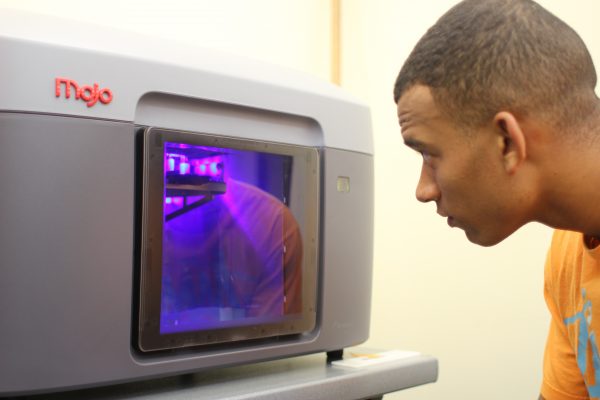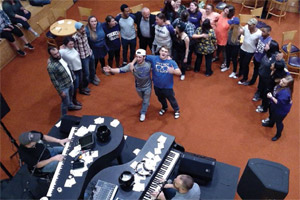Engineering program accelerates rapidly

At the beginning of year two, Professor Brian Johns and Cornell’s new engineering program continue their rapidly accelerating trajectory.
“It’s been a lot of work, there’s no doubt about that,” says Johns, assistant professor of engineering and the person charged with getting the new major off the ground. “But it’s a great opportunity.”
Since coming on board last year, Johns has focused on developing an engineering major within a liberal arts context, including an Introduction to Engineering Design, which is open to any Cornell student. Cornell’s engineering program broadly covers electrical, civil, chemical, and mechanical engineering.
In its first year, six students declared the engineering sciences major. The Department of Physics and Engineering offered five engineering courses, in which an additional 57 nonmajors or future majors were enrolled. Fifteen members of the incoming Class of 2020 have expressed interest in the major. Johns would like 30 incoming students each year.
His efforts are augmented by physics professors Kara Beauchamp, Lyle Lichty, and Derin Sherman. They are offering four new courses this year and will continue to offer new courses every year.
“We’re emphasizing hands-on learning,” Johns says. “I want our students doing engineering things. We’re creating a ‘culture of building’ where students can dream up designs and come down to our shop to make their ideas a reality. That kind of hands-on experience is sought after by employers.”
He says the One Course At A Time schedule makes this engineering program uniquely hands-on. “Unlike many other engineering programs,” he says, “Cornell students complete resume-quality projects in every engineering course.”
From the first engineering course, Introduction to Engineering Design, students learn to innovate and collaborate in teams, creating original designs and prototyping their creations using 3-D printers. Students advance their fabrication skills in every succeeding course, culminating in a final capstone project based on their broad knowledge attained throughout their education.

A trio of students in a recent Intro class created replacement eyeglass frames using a computer-aided design (CAD) program and a 3-D printer.
“We wanted to solve a problem that our friends had—people who have glasses break their frames a lot,” Amanda Bentz ’18 said. “So, we decided we would make something that could replace a broken set of frames until they could go to the doctor and get a new set of frames.”
They had to think through each of the pieces on the replacement frames, from the tiny screws to the nose piece. The idea is that the lenses of any glasses could fit into the replacement frames and that the frames would fit just about anybody. Even though the class is over, the project is not. Johns told them this project could have a broader application with more uses, which made them think about the future, and they are researching patent law and exploring how to get it to nonprofits for developing countries and low-income families.
The ability for students to make things has been enhanced this year with the addition of new equipment that arrived over the summer, including a computer-controlled lathe, milling machine, a new table saw, and a new 3-D printer, all of which are located in the engineering machine shop.
“We’re going to incorporate the machine shop into more courses,” Johns says. “I’d love to see students coming to the machine shop to make things and to hang out.”
In addition to the machine shop, engineering students utilize a computer lab in Cole Library where they complete design work.
In typical Cornellian style, Johns isn’t just teaching engineering skills. He’s pushing his students to meld their technical knowledge ability with critical thinking and leadership ability.
“The goals for my students are to become the leaders of tomorrow–not just the people who sit in cubicles and have the technical skills to succeed, but the people who can go out and become the CEOs, CTOs, and engineering managers,” he says.


